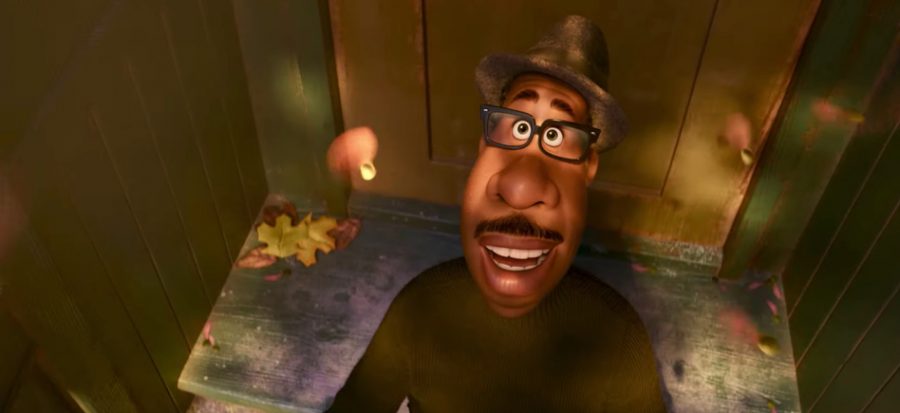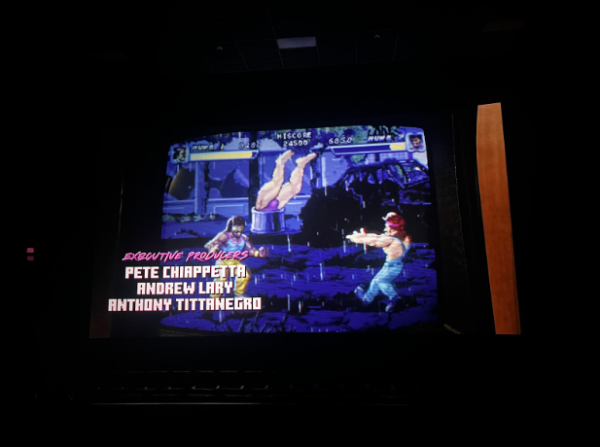“Soul” finds Pete Docter at his existential and life-affirming best
Pete Docter’s newest feature combines his usual brilliant creativity with one of Pixar’s most intrepid visions.
Jamie Foxx stars as Joe Gardner in Pixar’s 23rd feature film.
On Friday, Dec. 25, Pixar released “Soul,” its 23rd feature-length animated film, to its streaming platform Disney+. The film stars Jamie Foxx and Tina Fey and centers around Joe Gardner (Foxx), a middle school band teacher with a passion for jazz. After he gets into an unfortunate accident following a successful jazz tryout, he becomes separated from his body and enters a state of preexistence. There, he meets the infamous soul, 22 (Fey), and they go on a journey to help Gardner’s soul reenter his body.
As with Pixar’s best work, the film is gorgeously animated. What separates Academy Award-winning director Pete Docter, one of the best directors to work in the animation business, from the rest of the pack is his uncanny ability to provide a unique function or look to each of his films. He’s done this from every monster in Monstropolis in “Monsters, Inc.” to every function of Riley’s brain in “Inside Out.” And in “Soul” he’s able to boldly apply his magical touch to theoretical planes of existence.
“I thought the art style was pretty cool. I loved seeing Terry appear in street signs and stuff in our world. Also, I think they did a great job with body image and how not every protagonist in a story has to look like a superstar,” said Jacob Chisholm, junior.
In preexistence, an array of lush blue landscapes gracefully fly across the screen. Each soul, representing a future human, is given a lighter turquoise look in order to both stand out among and emphasize the beauty of the ethereal landscape. Meanwhile, on Earth, the hustle and bustle of New York City is displayed expertly. This tension is best illustrated during a short chase scene where Gardner, whose soul is stuck in a small cat, has to chase 22, whose soul is stuck in his tall body.

One of Docter’s most underlooked traits as a director is his ability to control the tone of a scene. In the famous scene where Carl and Ellie grow together in his film “Up,” Docter was able to deftly illustrate high and low points in their life through his use of harsh lighting contrasts. In “Soul” he does this on numerous occasions as well. When Gardner meets a personal hero of his, Dorothea Williams (Angela Bassett), the ambient lighting of the dark jazz club shines on her like a spotlight in front of the backdrop of a red curtain.
Docter’s primary and best use of ambient lighting to create the tone of a scene involves the sun. He uses the giant star to highlight intimate or happy tones in a scene. In one particular scene in the film, the sun shines through a tree as one of its seeds nimbly glides through the air into Gardner’s hand. The scene serves as a culmination of 22’s, still stuck in Gardner, growing love of Earth. The Sun merely serves as an exemplification of the intimacy and strength of 22’s love.
Pixar has never struggled to find good voice actors, and this film is no different. In Foxx’s portrayal of Gardner, he manages to proficiently hypnotize the audience into his dynamic. From the beginning, we understand and thoroughly believe his passion for jazz. We feel this as he reminisces upon the beginnings of his passion, through the excited pitch in his voice when he hears about the splendid Williams, and through the struggle to find his words after he gets lost in a symphony of the music.
While Fey isn’t as compelling as Foxx, she was able to deliver 22’s growth as she lives life on Earth very effectively. She plays off of Foxx’s more brash and ignorant perspective in a way that smoothly provides a conclusion for both of their character arcs.
The film’s script, written by Docter, Mike Jones, and Kemp Powers, manages to exude the frightening nature of existentialism while also remaining concise in its message. The film’s scope is arguably the boldest that Pixar has attempted. This only gets better when combined with the film’s disciplined and extremely creative world-building.
Given its scope, the film takes the opportunity to poke fun at higher powers and has some moments of surreal and black comedy. One particularly funny scene involves one celestial being sending five souls to have an insecure personality and 12 souls to have a self-absorbed one. The other then remarks that they should stop sending so many souls through that area.
But, perhaps its best feature is the film’s relatability. This is a film whose message can be applied to everyone at any particular time in life. Its themes reflect a power and understanding of life similar to a Terrence Malick film. We all experience the repetitiveness of life and all fall into losing its significance. In essence, we all become the fish that’s looking for the ocean.
“I personally connected to the film, and I cried for a while after the movie because I was so moved,” said Hannah Tatum, sophomore.
In times like those, life becomes very frightening and we can truly grasp our powerlessness against it. It’s a fear that can be detrimental to some people. And the film not only understands this but empathizes with it as well. It essentially takes Docter’s life-affirming style but applies it to a more courageous vision. While we are all the fish, that doesn’t mean we can’t take the time to look around the vast body of water to really realize what we’re looking for.
“I felt very reflective at the end of the film and eager to find my own true passion and start living every day like it was my last,” said an anonymous senior.
You can watch “Soul” on Disney+ with a monthly subscription.

Steven, a senior, is enthusiastically returning to the Devils' Advocate staff this year. He loves to watch the Cubs and analyze statistics in baseball,...













